Industry City and the Police Power of Zoning
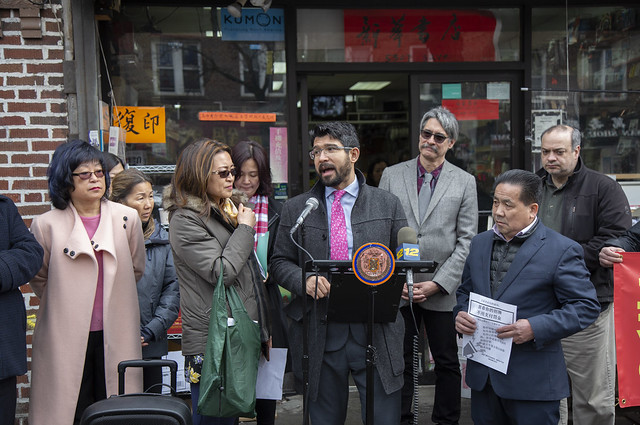
Council Member Menchaca and constituents (photo: John McCarten/City Council)
In the past week, the New York Post and New York Daily News published editorials criticizing New York City Council Member Carlos Menchaca’s March 6 request to delay the certification of a consortium of major real estate investors and developers’ application for a special permit to build two hotels and rezone Industry City for retail, office, and academic uses. The accusatory language in both newspaper editorials exhibits a deep contempt for the necessary public review of private development proposals.
This massive rezoning would greatly increase the density of commercial uses and allow three new buildings with 1.27 million square feet of market-rate, destination retail, hotel, and academic office space, and more importantly, will fundamentally and irrevocably alter the industrial working waterfront.
Menchaca and Community Board 7 requested more time for community review because “ULURP has historically failed to address the most urgent concerns voiced by the Sunset Park community.” A spokesperson was quoted in the RealDeal that Industry City “intend(s) to make our case” through the ULURP process but ultimately agreed to a postponement after Congressional Representatives Nydia Velázquez and Jerry Nadler, and State Senator Zellnor Myrie intervened with a letter to City Planning Director and Chair Marisa Lago.
The Post described Menchaca’s request as “holding Industry City hostage” in order to “blackmail” the developers for a “payoff to the activists.” The Daily News demanded that City Council members cease their “corrupting power on land-use matters” by pointing to Amazon’s February announcement of the withdrawal of a plan to build a massive campus in Queens. In concert with the Post, the Daily News similarly admonished Menchaca’s “meddling” and “extortion,” and demanded that he “must relent” and “the Council must end this craziness.”
I teach an introductory urban planning class and we spend weeks on the complicated topic of zoning. One of the first things we learn is that the legitimacy of zoning is based on the legal concept of municipal police power which refers to the right of the community to regulate the activities of private parties to protect the interests of the public. Menchaca requested a postponement in the certification of Industry City’s rezoning application in order to provide more time for a full vetting of public interests and concerns. This is not an unreasonable request especially as Menchaca’s letter notes displacement and gentrification concerns, and specifically requests Industry City to explain “how its rezoning proposal will mitigate displacement, gentrification, rising rents, congestion, and the effects of climate change.”
Despite indisputable evidence of Sunset Park gentrification including a NYU Furman Center study, the Post editorial repeated Industry City’s delusional claim that since its rezoning does not involve residential development, “it’s irrelevant to gentrification.” Industry City CEO Andrew Kimball’s letter stated that in order to have “modern manufacturing and making at Industry City,” the Special Sunset Park Innovation District rezoning must include “a mixture of uses that allow for a higher return.” And as page 6 of the Draft Scope of Work makes clear, Industry City needs the rezoning for “upscale” hotels, expanded destination retail, and new academic uses because without these city actions, it will not be able to raise $638 million in capital investment. Although Kimball argues that Industry City provides an antidote to gentrification through job creation, he has yet to specify the numbers, types, and wages of “high-quality” innovation district jobs that would be available to Sunset Park’s working age adults (of whom nearly one in two lack a high school diploma).
Industry City’s rezoning is essential to “generating the economic returns necessary to finance additional capital investment in the portfolio” in order to enhance and maximize property value and rent revenues (i.e., high-rent tenants).
As currently proposed, this rezoning will diminish one of New York City’s last remaining industrial waterfront neighborhoods, and as UPROSE Executive Director Elizabeth Yeampierre notes, it also represents a lost opportunity for a frontline community to advance innovation, inclusion, and resilience in the face of climate change. For these reasons and the right of Sunset Park’s Latinx-Asian working class to remain in the neighborhood, we must end the craziness of zoning in the service of the private market and enrichment of real estate developers rather than its intended purpose to protect the health, safety, and welfare of the public.
***
Tarry Hum is a professor at The City University of New York (CUNY) and author of Making a Global Immigrant Neighborhood. On Twitter @TarryHum.
***
Have an op-ed idea or submission for Gotham Gazette? Email This email address is being protected from spambots. You need JavaScript enabled to view it.
The Power to Prevent New Infections is In Our Hands
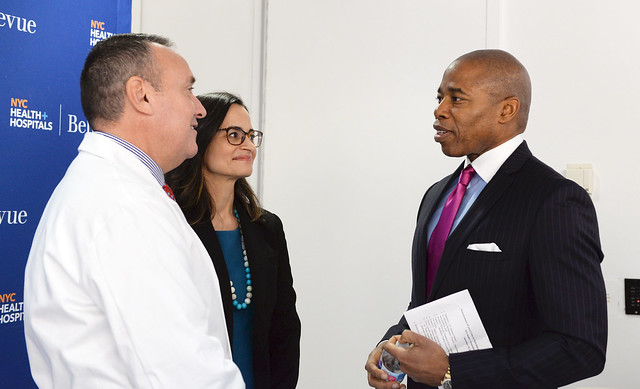
Brooklyn BP Eric Adams, the author (photo: Erica Sherman/Brooklyn BP's Office)
The world of medicine has advanced significantly in the battle against many chronic diseases, including the discovery of the polio vaccine and reversing the effects of diabetes and heart disease. However, one battle continues to be fought in research labs and on the ground in communities across America and around the world — the fight to end the HIV/AIDS epidemic.
While New York State has been a fearless leader on a national level in the effort to end this disease, Brooklyn remains the epicenter of a persistent health crisis. To tackle this head-on, the State set an ambitious goal of ending the epidemic by 2020. Thanks to the diligent work of advocates, community-based organizations, and health care providers, the target is within reach.
Yet statistics reveal a disturbing trend that must be addressed to complete the mission. Data from the New York City Department of Health and Mental Hygiene (DOHMH) reveals that 2017 HIV diagnoses were down to a record low of 2,157 citywide. Though this progress is encouraging, the rate of reduction is slowing, from an 8.6% decline in new diagnoses in 2016 to 5.4% in 2017. Brooklyn bears a disproportionate burden of the HIV/AIDS epidemic, with more than 30,000 of our neighbors living with HIV.
In 2017, our borough experienced 640 new HIV diagnoses, representing a 10.15% increase in new diagnoses from the previous year — making Brooklyn the only borough with an increase. Most alarmingly, Bedford-Stuyvesant and Crown Heights are the hardest-hit neighborhoods citywide, accounting for a quarter of new diagnoses in our borough.
Today -- Wednesday, April 10 -- we recognize National Youth HIV and AIDS Awareness Day. I continue to be concerned that each year since 2013 Brooklyn has more HIV diagnoses among youth aged 13-29 than any other borough. We owe it to our community’s young people to allow them to live in a world without AIDS.
We cannot let the promise of an end to HIV miss the mark by neglecting our most susceptible communities that have already been neglected through generational poverty, institutional racism, and unequal access to quality health care. We have tools at our disposal to end this epidemic, particularly by expanding Medicaid Special Needs Health Plans (SNPs), which are designed to address the needs of individuals living with or at higher risk for HIV. These specialized health plans help members access treatment so that the virus becomes suppressed or “undetectable,” meaning they are unable to transmit HIV to others.
The more people we help achieve undetectable status, the closer we are to a society without HIV and AIDS. SNPs also have the expertise to connect HIV-negative individuals with effective prevention methods such as pre-exposure prophylaxis (PrEP) and post-exposure prophylaxis (PEP) so they can remain negative, saving $1 billion in state Medicaid costs for every 2,000 new infections.
The sectors of the population most at risk for contracting the virus are certainly those who will benefit most from an expansion of this crucial program. The State’s “Blueprint to End the HIV/AIDS Epidemic by 2020” lists include men who have sex with men (MSM), people of transgender experience, women of color, HIV-negative partners in couples in which one person is HIV negative and the other is HIV positive, and people who are intravenous drug users as populations at higher risk for HIV.
To reduce the rate of HIV in Brooklyn and reach the 2020 eradication target, we must reach these vulnerable populations and ensure they receive the culturally competent services needed to remain HIV negative. At present, of the populations identified by the State as being at higher risk, only HIV-negative transgender individuals are currently eligible to enroll in SNPs. To reach the end of this epidemic, this must change.
Consider the clear scientific evidence that PrEP is more than 90 percent effective in preventing HIV transmission, yet the largest portion of New York State Medicaid recipients taking PrEP – 37% – are white gay and bisexual men despite black and Latino gay and bisexual men being hardest hit by the epidemic. We need to expand SNP eligibility and outreach to communities of color in the hardest-hit parts of our city to connect them to the services they need to get tested, treated, and enrolled.
We have the tools at our disposal to revolutionize the way we combat the HIV/AIDS epidemic. The power to prevent new infections is in our hands.
***
Eric L. Adams is the Brooklyn borough president. On Twitter @BPEricAdams.
***
Have an op-ed idea or submission for Gotham Gazette? Email This email address is being protected from spambots. You need JavaScript enabled to view it.
Students for School Safety: Solutions Not Suspensions, Counselors Not Cops
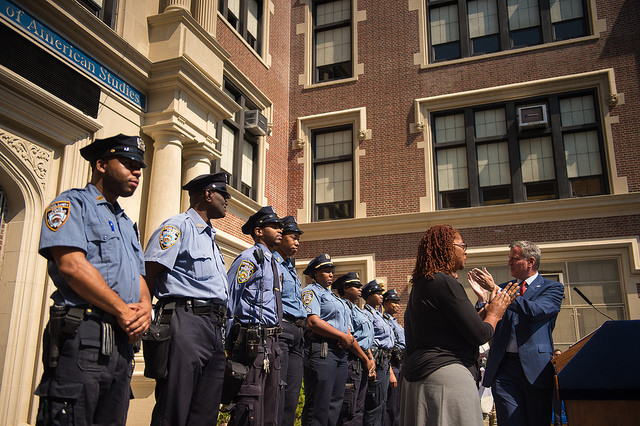
(photo: Rob Bennett/Mayoral Photography Office)
Recently, many news outlets have sensationalized the declining use of suspensions in New York City, framing young people negatively and attempting to discredit the progress that has been made. These stories discount the needs of students most impacted by punitive discipline, who have been very clear about the urgency around redefining what school safety really means.
And while suspensions are down across the city, too many schools still use ineffective tactics, choosing to exclude students rather than seeking to better understand them. Relying on tactics like suspensions, or even metal detectors, handcuffs, surveillance cameras, installing gates on windows, and hiring more school safety and police officers only fosters feelings of turmoil.
As two students currently enrolled in Brooklyn high schools, we understand the circumstances and we understand the impact of suspensions and policing on young people. We must end the school to prison pipeline for the sake of ensuring a better future for the next generation of children.
On March 20, we testified before the New York City Council to draw attention to both the financial and social cost of criminalizing young people in school. Last year the city adopted a budget that was going to spend $373 million on the School Safety Division of the NYPD. The mayor’s new preliminary budget shows a $30 million increase in that funding, now expected to reach $403 million. This would be the most that the city has ever spent on school policing. This isn’t a step in the right direction. This is a crisis.
The city needs to redirect funds toward positive and healing alternatives that work, such as more guidance counselors, clinical social workers, school psychologists, and access to restorative justice that all can boost the morale of students across campuses and increase the academic engagement of students to help them graduate.
The Department of Education recently released its 2019 data report on the number of guidance counselors and social workers in all New York City schools. According to that report, across 913 school sites covering grades 6 through 12, there are 449 schools listed that do not have a single social worker, and 40 school sites that do not have a single guidance counselor. Schools are too ready to push towards more desperate, punishing measures when it would be more positive and transformative in the long run to invest in what helps students feel whole.
Funneling public money towards ensuring students are policed in schools is not safety. Ensuring a future where people respond to problems with criminalization is not the answer.
We’ve both been to Albany to advocate for the Safe and Supportive Schools Bill that would encourage schools across all of New York State to shift away from punitive practices. We are both committed to helping build the schools people need to thrive. Supportive, respectful schools where students are treated with dignity is what will bring us safety.
***
Gary Edwards is a high school senior and Khushayah Morris is a high school sophomore. Both students are education justice advocates with the Children’s Defense Fund - New York, and members of the Dignity in Schools Campaign of New York.
***
Have an op-ed idea or submission for Gotham Gazette? Email This email address is being protected from spambots. You need JavaScript enabled to view it.
Keeping the Lights On Off-Broadway: How the City Must Step Up
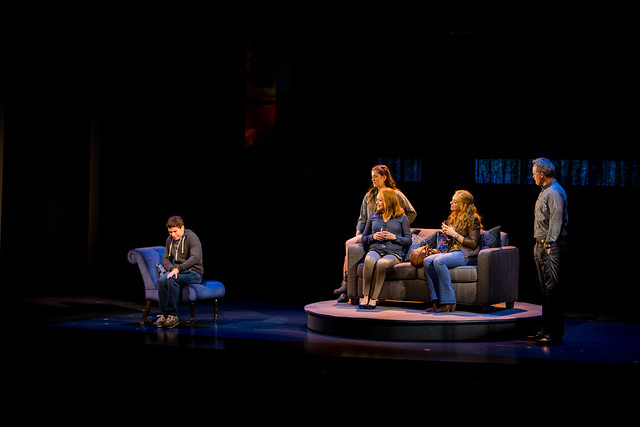
(photo: Benjamin Kanter/Mayoral Photo Office)
Seeing an Off-Broadway play may have saved my life. Joseph Papp gave me my first acting job in 1985, in Shakespeare in the Park, and offered the cast free tickets to Larry Kramer’s “The Normal Heart” running at The Public, which showed the devastation AIDS wrought on a community forsaken by governments and the press, and its fight to save itself. Seeing the play as a 22-year-old gay man, it scared me into celibacy for a few years, until safer sex guidelines were ingrained in our culture.
Off-Broadway, more than any other facet of New York’s cultural scene, shines a light on underserved communities.
It puts the city’s rich demographics on stage. Jose Llana, who played Ferdinand Marcos in David Byrne’s musical “Here Lies Love” at The Public, said, ”I’ve learned that, as an actor of color, the most daring work, where people tend to hire people who look like me, is Off-Broadway.” Off-Broadway is also an economic engine for the city. Recent Tony-winning musicals like “The Band’s Visit,” “Hamilton,” “Dear Evan Hansen,” and “Fun Home,” all originated or transferred from Off-Broadway, and those hits helped Broadway generate huge revenues, with almost $2 billion in ticket sales last year and contributing many billions more to the city’s economy each year. In the 2007-08 season—the last year a study was done, though another is expected soon —Off-Broadway itself enriched the local economy by almost half a billion dollars. But that success isn’t reflected in Off-Broadway wages.
Ironically, as Off-Broadway theaters become more inclusive in the stories they present and the artists they use to tell them, those from underserved communities are shut out from careers in the arts. Low wages hit early-career artists from working class and working poor backgrounds the hardest, barring entry for those who are disproportionately from communities of color and rural communities. A life in the theater is really available only to those who can afford it. Almost every Off-Broadway artist can tell a story of chronic economic distress: Nick Westrate was a recent Juilliard graduate when he enjoyed a continuous year of employment Off-Broadway, earning a special Drama Desk Award for his work in four different plays; three days before the ceremony, attended in a borrowed suit, he declared bankruptcy.
After two years of working exclusively Off-Broadway, two-time Tony-nominee Johanna Day lost her apartment of 14 years because she couldn’t afford it; she then painted houses in Virginia to supplement the income for her next Off-Broadway play, and still ended up losing money.
Obie-winner François Battiste, after working full-time at Lincoln Center while keeping his day job caring for homeless youth at Covenant House, and with a second child on the way, departed for more affordable Sacramento.
200 of these stories were the force behind our Fair Wage OnStage campaign in 2016, during negotiations between Actors’ Equity Association, the labor union of theatrical stage managers and actors, and the League of Off-Broadway Theaters and Producers. Our group of activists organized over 1,700 Equity members and agitated for higher wages with grassroots actions, taking to social media to tell of the hardships brought by substandard wages. Without resorting to a strike, Equity won wage gains of 14% to 81% over the five-year life of the contract.
While proud of this success, we have further to go. In a 2016 Equity survey, Off-Broadway workers reported needing $815 net per week on average, or $1129 before taxes, just to pay their basic expenses.
Only one non-Broadway, non-profit space in the five boroughs, The Public’s Newman Theater, pays actors just over $1,100 per week. Twenty-six theaters pay actors anywhere from $650 to $950 per week. Over 30 fall below $650 per week, with many paying little more than minimum wage. Trump’s tax cuts make things even worse, eliminating protections for performing artists built into the old tax code. Actors incur many unreimbursed employee expenses. The new law eliminates itemization, and expenses often go well past the new, higher standard deduction, as much as quadrupling our tax burdens, according to Sandra Karas, Equity’s treasurer and a tax lawyer who’s prepared thousands of performers’ returns. New York City can help. New York City gives more money to cultural institutions and programs than any city in the country: last year’s Department of Cultural Affairs budget was $143.8 million, outpacing the arts funding of San Francisco, our nearest rival, by over $60 million. But 70% of the city Department of Cultural Affairs budget is reserved for 31 institutions in the Cultural Institutions Group, leaving over 1,000 other organizations to clamor for the rest. These august giants soak up most of the funds, so that very little reaches the people who make up the floor of our cultural ecosystem, the artists and the small companies that nurture them. We believe New York City can do better.
We propose the Fair Wage OnStage Fund, a concentrated allocation of money within the Department of Cultural Affairs budget, to subsidize professional stage managers and actors while they are employed in New York’s non-Broadway, nonprofit theaters, making up the difference between established union minimums and what we actually need to survive. Nonprofit theaters within the five boroughs using contracted Equity workers at minimums that fall below the necessary weekly gross salary—$1,129 per week, adjusted annually for inflation—would be eligible for the fund. Theaters would be responsible for raising the money to pay established minimum salaries and benefits, and could only use the fund to pay the difference between what the artists get and what they need. As an annual allocation, the FWOS Fund would have a built-in, yearly sunset provision, so it won’t interfere with union negotiations.
By our rough estimate, just over 1,500 contracted, Equity stage managers and actors worked in non-Broadway nonprofits in the five boroughs during the previous theatrical season, grossing an average of $646 per week. To fill the gap between this and the necessary wage, the FWOS Fund would subsidize these workers with, on average, around $483 per week. A nonprofit theater contract is usually nine weeks long. The fund would pay, on average, $4,347 per contract. For 1,500 contracts over a season, the fund would disburse roughly $6.52 million, less than a hundredth of a percent of New York City’s $90-plus billion budget.
New York can afford the Fair Wage OnStage Fund.
Unlike Washington, D.C., Philadelphia, Houston, San Francisco, Long Beach, and the State of Minnesota, New York City has no revenue stream dedicated specifically to the arts. If the city seeks an untapped source, a tax of a fraction of a dollar on a Broadway ticket—with 13.79 million tickets sold last season—would pay for the fund and then some. Or, since the city’s lack of affordability affects so many of us, a proposed tax on unoccupied luxury apartments, which inflate housing prices all over the city, would be a just source of revenue to support the city’s artists.
Like other Department of Cultural Affairs initiatives regarding cultural institutions—studying the demographic makeup of staff; free admissions for public school students and for undocumented immigrants with city ID cards—the FWOS Fund would encourage cultural equity. In a city whose enormous wealth drives artistic workers further to the margins (or out of the city completely), where the rising cost of living keeps many from even getting in the door, the FWOS Fund would act as a stimulus package for the artistic workers who help generate wealth, but see little in return. As City Comptroller Scott Stringer put it in his report “Culture Shock: The Importance of National Arts Funding to New York City’s Cultural Landscape,” “A robust and healthy cultural sector supports a robust and healthy democracy and economy.” The FWOS Fund will cultivate a more robust, healthier Off-Broadway, helping New York retain its artists and attain its rightful status as an example for the rest of the nation in properly valuing its artistic workers and creating equal opportunity for all.
***
Robert Stanton for Fair Wage OnStage. On Twitter @FairWageOnStage.
***
Have an op-ed idea or submission for Gotham Gazette? Email This email address is being protected from spambots. You need JavaScript enabled to view it.
It’s Time to Get Big Money Out of the Climate Change Fight
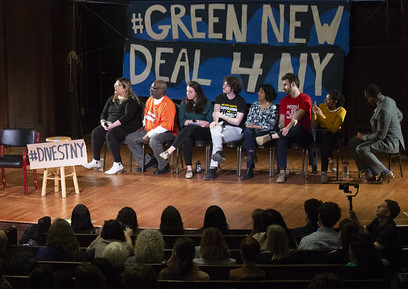
(photo: John McCarten/NY City Council)
The window for meaningful action on climate change is narrowing. Every year, as more climate impacts become “locked-in,” changes we have to make to save the planet become even harder to implement. Right now, fossil fuel industry campaign contributions to politicians are holding back the solutions we need.
If we want to pass climate policies that could actually help reverse the climate crisis, then we also need to fix our democratic system that gives too much power to wealthy donors and big polluters. In New York, a state where wealthy donors contribute an outsized proportion of funds to campaigns, we have the opportunity to build a public campaign financing system that can address this imbalance. These two crises are interconnected.
Nationally, the fossil fuel industry has tightened its stranglehold on American politics. In the 2018 election cycle alone, $89 million in campaign contributions came from the oil, gas, and coal industry with the vast majority going to Republicans. Contributions from the fossil fuels sector put a stop to ballot initiatives that would have created landmark state climate and energy legislation here in New York—and across the nation.
In the battle over fracked gas development in New York, oil, gas, and fracking support industries spent $10.7 million on contributions and $33.5 million on lobbying from 2007 to 2013, stalling several fracking restriction measures. While grassroots activists eventually succeeded in pushing Governor Cuomo to take executive action to ban fracking, this influx of pro-fracking cash signals potentially bigger battles ahead as the state considers a 100% renewable energy target.
In 2018 in Washington state, $31.5 million was pumped mostly from mostly out-of-state oil and gas industry into a campaign that ultimately defeated a carbon tax measure that would create revenue for renewable energy and vulnerable communities. And a proposition that would have set restrictions on gas fracking in Colorado was defeated after oil and gas spent over $26 million in the state.
That is why a growing chorus of environmental advocates is calling for public financing of elections — which expands the contributions of small donors through public matching programs. With a fair elections system, elected officials would be more responsive to the electorate, an overwhelming majority of which believes we need bold policies to address climate change.
One of our best hopes today is here in New York, where lawmakers are on the cusp of passing groundbreaking climate policy and the state budget has just included a commission mandated to develop a public financing system for the state.
Public financing of elections would fundamentally change how Albany works, and amplify the power of working people and people of color. In the long term, fair elections mean that our elected officials will be more engaged with constituents in their districts and responsive to public concerns and needs.
To implement an effective fair elections program, legislators and Governor Cuomo must appoint commissioners committed to expanding access to our democracy. A robust program would also include a 6-to-1 contribution match for low-dollar sums, lower contribution limits, and an independent agency to administer the program. In order to limit the influence of big donors who seek to block effective climate policy and other urgent reforms, the commission must act quickly and decisively. Kicking the can down the road is not an option.
Simultaneously we can pass the Climate and Community Protection Act (CCPA) to put New York on a path to 100% renewable energy economy-wide. The CCPA is ground-up policy, with a coalition of over 160 groups from across the state backing the proposal. The bill puts in place requirements for energy investments to go to disadvantaged communities, and working groups that include community group representatives to oversee implementation of state energy plans. This means more people could be part of shaping an equitable energy transition for New York.
The impacts of climate change are not felt equally by all. We need to ensure a more inclusive political process to address everyone’s needs, especially those most vulnerable to climate impacts and pollution, and communities that have been historically excluded from political decision-making.
We have the technology we need to begin a rapid transition to a renewable energy economy. Our ability to implement climate solutions is, therefore, a political question. With the majority of New Yorkers in support of government action to curb climate change, a legislature that is more responsive to the electorate could usher the ambitious climate policies we need. Public financing and bold climate measures like the CCPA can reorient our politics to expand who is heard and who is at the table.
***
Bill Lipton is the New York State Director of the Working Families Party. Adrien Salazar is a Campaign Strategist with Dēmos and one of the 2019 Grist 50 Fixers. On Twitter @BillLipton of @NYWFP & @adrien4ej of @Demos_Org.
***
Have an op-ed idea or submission for Gotham Gazette? Email This email address is being protected from spambots. You need JavaScript enabled to view it.
Invest in City Parks to Improve Our Public Spaces and Save the Environment
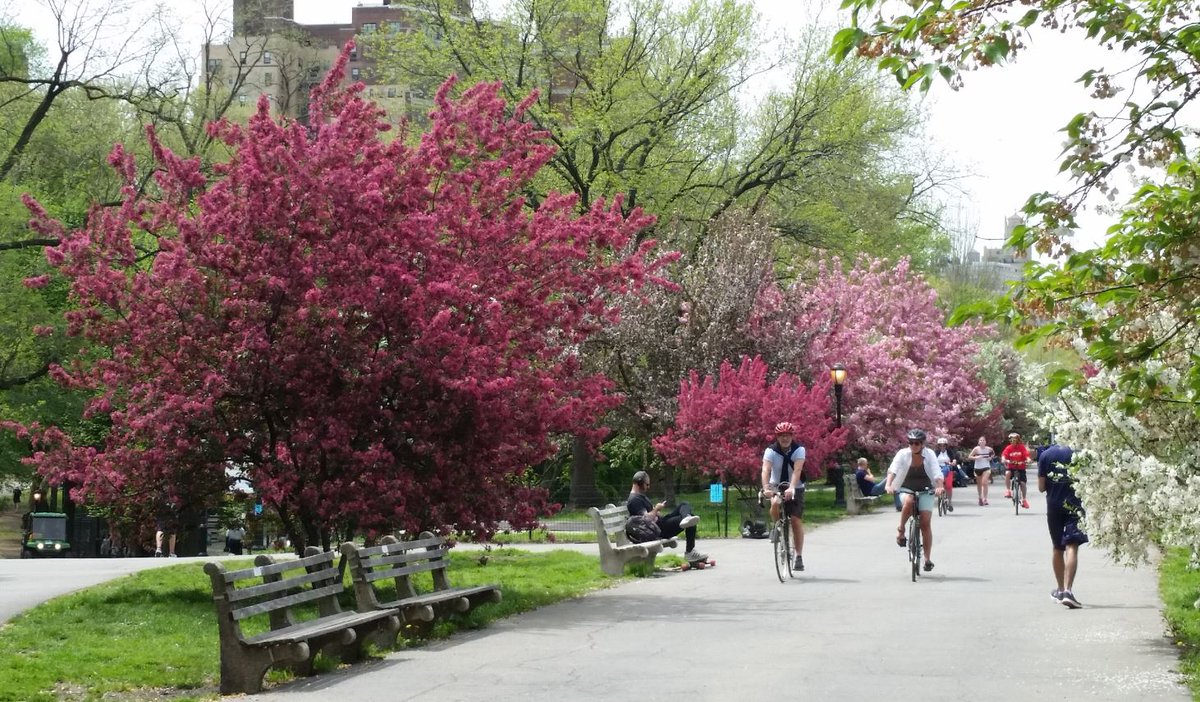
(photo: @RiversideParkNY)
Parks are an essential part of any city’s infrastructure. Getting into nature at an urban park lowers stress, eases depression, and fosters happiness. Parks help build community - people get out and meet each other, kids play together, mothers talk, residents meet neighbors.
Parks are particularly invaluable in New York City, the nation’s most densely populated city. And we are fortunate to have so many parks to enjoy! More than 81% of New Yorkers are within walking distance of public green space. New Yorkers are visiting city parks in unprecedented numbers. The city’s parks get more than 100 million visitors a year.
More than just places to commune and recreate, these greenspaces are also one of the city’s most valuable environmental assets. They provide clean air, help mitigate climate change, connect residents with nature, and provide habitat for wildlife.
Parks are a major source of the city’s urban tree canopy. That canopy removes 1,300 tons of pollutants from the atmosphere and stores 1.2 million tons of carbon per year. Trees are vital for mitigating the urban heat island effect and can lower air temperatures by up to nine degrees, cut air conditioning use by 30%, and reduce heating energy use by a further 20-50% -- all of which help decrease climate-changing emissions.
The city’s parks and trees also contribute to our resiliency, capturing almost 2 billion gallons of stormwater runoff each year.
The New York City Parks Department manages 30,000 acres of land, about 14% of the city. Sadly, Parks receives less than 1% of the total city budget, leaving our greenspaces at risk.
This is shameful. While New York spends $178 per capita on its parks. Minneapolis spends $233, and Washington D.C. spends $270.
The average city park has not seen a major renovation for more than 20 years. According to a Center for an Urban Future report, there are cracks in virtually every retaining wall in city parks, deteriorating bridges, toilets that flush directly into waterways, drainage systems that can’t handle the runoff from even a gentle rainfall, and myriad other problems. Managers can’t do any kind of systematic planning and major infrastructure projects are often put on hold for years.
Inadequate funding for proper maintenance has also led to a rise of invasive species in parks. Just over a year ago, invasive beetles were found in Prospect Park that cut off the supply of water and essential nutrients to trees.
The great irony of all of this is that New York’s parks are iconic. Central Park and Prospect Park are routinely found on top parks lists.
That’s why NYLCV has joined the Play Fair coalition with New Yorkers for Parks, DC 37, and more than 100 other groups. Play Fair is a multi-year advocacy campaign for parks and this year, we are calling for increasing the Parks Department budget by $100 million for better maintenance.
This investment could ensure that the city’s natural forests will begin to receive the proactive care they need to remain healthy and resilient in our changing climate. Maintenance workers would have the resources they need to protect our trees from invasive species and maintain the trees we need to absorb carbon and air pollution.
It would go a long way towards fulfilling the goals of the 25-year Forest Management Framework for the restoration and conservation of the city’s hard-working natural forests, for which NYLCV has been advocating.
Investing in maintaining our parks will make New York City more sustainable, improve resiliency, and conserve nature. It’s time we Play Fair for our parks.
***
Julie Tighe is President of the New York League of Conservation Voters (NYLCV), the only non-partisan, statewide environmental organization in New York that takes a pragmatic approach to fighting for clean water, healthy air, renewable energy, and open space. On Twitter @julietighe17 & @nylcv.
***
Have an op-ed idea or submission for Gotham Gazette? Email This email address is being protected from spambots. You need JavaScript enabled to view it.
We Can’t Effectively Plan for Climate Change without Real Community Dialogue and Long-term Planning
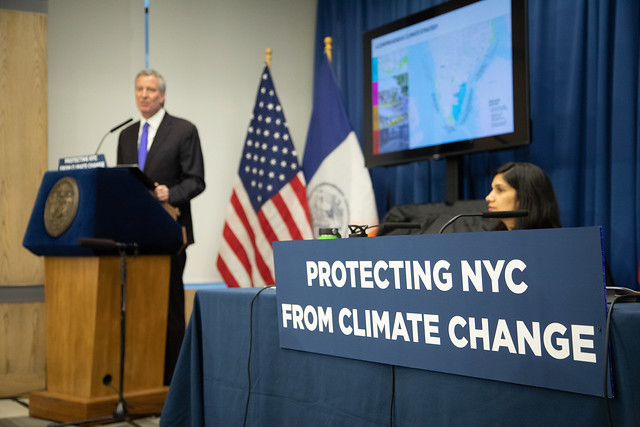
(photo: Paige Polk/Mayoral Photography Office)
As we march toward a new climate reality, are we leaving the public behind? The New York City Panel on Climate Change’s (NPCC) 2019 report, released on March 15, offers a sobering new lens known as the Rapid Ice Melt scenario: the metropolitan region could experience 9.5 feet of sea level rise by the end of the century. That’s six inches short of the height of a regulation basketball hoop.
The real ‘March madness’ spilling into April and beyond is that we have barely any plan or resources to adapt our broader metropolitan region and, most important, effectively educate and engage the public about the financial, environmental, and social tradeoffs that will become increasingly necessary as waters rise. These are hard conversations. But they are also an opportunity to engage in a dialogue about how we will shape our cities for generations to come.
In this discussion, process and communication matter. Mayor de Blasio’s surprise roll-out on March 14 of the Lower Manhattan Coastal Resiliency project, which features a precedent-setting plan to infill up to 500 feet of the East River to protect the Financial District, echoes cautionary tales of two other disputed plans that have fallen short of the kind of public engagement necessary to succeed.
A substantially updated and fast-tracked proposal for the resiliency of Manhattan’s Lower East Side and the aborted Long Island City Amazon campus reveal an unwelcome common thread: big ideas that carry great importance for the economy, environment, and resilience of our city require understanding, buy-in, and a sense of how they fit into a plan for the larger whole, before they are presented to the public.
Questions remain about the details of alternatives for the Lower Manhattan Coastal Resiliency project, not to mention what follows. Does our city of water become a city of levees? What about equity? And are we setting a damaging standard for environmental impacts?
It is hard not to consider the ghosts of past land use decisions that we have made, that have led to our present predicament: Water Street, Canal Street, Pike Slip, areas long since filled in to support our growth. Without a full understanding of (and say in) the trade-offs, it will be hard for the public to feel comfortable with a presumed conclusion.
Adapting to climate change is increasingly not just a choice about strategy, but about what fundamental changes to our coastal cities we are open to. All options should be on the table, but the public needs to see the iterations that got us to this point. These are first steps that will ricochet across land use decisions throughout New York City and beyond.
These are also decisions that require long-term plans, funding, and supporting governance frameworks that span beyond electoral cycles. Even if a Rapid Ice Melt scenario is not realized, the more modest sea level rise projections will mean that the Financial District, Coney Island, Rockaway Beach, Red Hook, the Historic Navy Yard, the Port of Newark, and the New Jersey Meadowlands, to mention a few, will all be under water daily by the end of the century if no action is taken. The questions expand: what is the future that we want, who will pay for this change, and how equitably will resiliency measures be distributed? We’re in this together.
New York is not alone of course. Miami, Norfolk, New Orleans, and scores of other coastal cities nationally and globally face these realities. But few rival New York City’s indomitable force of economy, innovation, and diversity. If we can’t do it here, this begs the question: can we do it anywhere?
While there was virtual radio silence greeting the release of the NPCC report, more than 1 million students across the nation and around the world walked out of class to express a serious statement about a need for real action to address our future. Those whose lives will be most affected by climate change get it.
We must address a true national emergency, together, and come to conclusions, together. As we consider bold steps forward, we must be informed by science, and organize robust and real public discussion to address the urgency. Can we talk?
***
Roland Lewis, President and CEO, and Kate Boicourt, Director of Resilience, are leaders of the Waterfront Alliance. On Twitter @OurWaterfront.
***
Have an op-ed idea or submission for Gotham Gazette? Email This email address is being protected from spambots. You need JavaScript enabled to view it.
The Business Imbalance is Bad for the City

(photo: Michael Appleton/Mayor's Office)
The political imbalance in New York City between business and “anti-business” forces is becoming untenable.
What is happening here has been in the works for many years and was not difficult to predict. Rising income inequality and the perception of a corrupt ruling class brought us the Tea Party movement, Occupy Wall Street, and the 2016 presidential candidacies of both Bernie Sanders and Donald Trump.
As the nation gears up for the 2020 presidential race, rhetoric pitting “corporate interests” against “the people” is once again front and center. And this is cascading down to our local politics in a way that risks damaging our city’s economic potential.
“Business” has become such a bad word that some elected officials have shunned accepting campaign donations or even attending meetings and events that might suggest an affiliation. And public policy debates are increasingly premised on the notion that business is an adversary and somehow acting in nefarious ways.
We must not continue down this path at the local level.
The business community is a pivotal constituency in New York City’s continued success. For example, the real estate industry has a huge stake in keeping the city humming if for nothing else than because their assets are inextricably linked to the city’s prosperity. Employers here want New York’s quality of life to remain high so their best employees don’t move to other cities. Why wouldn’t we want them to be at the table?
Drowning out the voices of business enables the loud voices of an influential few to drive public policy – without adhering to the will of the many. Pushing out Amazon – which had support from a majority of New Yorkers to locate a new campus here – is a “prime” example. In that instance, several high-ranking elected officials refused to even meet with the company. Two-thirds of New Yorkers agree that the loss of Amazon, its projected 25,000 jobs, and its tens of billions of dollars in expected tax revenues is bad for our city.
Now there’s another issue that is playing out in a similar way.
The state currently allows restaurants in New York City to pay waiters $10 per hour, so long as tips ensure that the employee is earning at least the minimum wage (now $15 per hour) at the end of the day. It’s called the “tip credit,” and it enables restaurants – which often have notoriously low profit margins – to reduce their labor costs. Surveys show that tipped workers end up earning $25 per hour, on average, when tips are included. Some make even more.
The issue should be a no-brainer. Indeed, the vast majority of restaurant owners and their wait staffs want to maintain the current system. (When Maine phased out its tip credit in 2016, thousands of servers led the successful fight to restore it because their paychecks were diminishing.) But a well-funded contingent of celebrities and misinformed activists are trying to drown out these voices in order to eliminate the credit in New York – and sadly, it seems to be working.
Some elected officials are repeating inflammatory talking points, namely that waiters are somehow not earning the minimum wage under this system. That would be of paramount concern to me, as well, were it not absolutely false. Yet no one seems to be listening to the facts, so unwilling they are to believe that employers and their employees could actually be on the same side of an issue.
New York City loses when policy debates adhere to this ‘business versus anti-business’ divide, particularly when the business side is assumed to be biased and dismissed as a result. I am certainly not advocating for pay-to-play politics, which is unethical, illegal, and at odds with the development of smart public policy. We need robust, thoughtful solutions that will move New York forward, remembering that we all believe in a better, stronger city for the future.
This requires public servants to engage with all parties and then make determinations based on all of these points of view. If we don’t maintain that balance, and base decisions on facts and impartial analysis, poorly-informed public policies will increase – and New York City will be worse for it.
***
Jessica Walker is President of the Manhattan Chamber of Commerce. On Twitter @jessinharlem & @ManhattanCofC.
***
Have an op-ed idea or submission for Gotham Gazette? Email This email address is being protected from spambots. You need JavaScript enabled to view it.
Doing Good Things Badly: Congestion Pricing and MTA Reforms
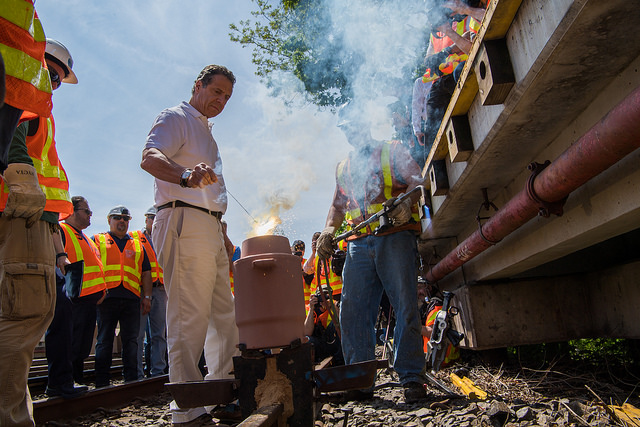
(photo: governor's office)
Everyone complains that our regional mass transit system is in disrepair, but no one wants to pay to make the needed fixes and modernizations. Have we finally found a way?
Ten years after legislation was first proposed by Mayor Bloomberg, the state Legislature passed a plan for what has been named “central business district tolling,” otherwise known as congestion pricing, in Manhattan as part of the fiscal year 2019-20 budget. The basic concept is that driving into the central core of Manhattan – defined as south of 61 Street – will incur a fee to achieve the multiple worthy aims of providing revenue for mass transit investments, cutting down on intense traffic congestion, and curbing air pollution.
Full details are still to come, with responsibility for administering the fee collection system vested in the Triborough Bridge and Tunnel Authority (TBTA), a subsidiary of the MTA, and the new charges will not go into effect until 2021.
Congestion pricing systems have been in effect in London, Stockholm, and Singapore for some time, but this will be the first such system in a major city in the United States. Given its novelty, the intensity of resistance from suburban legislators and officials (and indeed, even from some in Queens and from my dear, admired friend Dick Ravitch, a former MTA chair) and the distaste for user fees in general, it is a major accomplishment that this proposal was adopted.
Kudos are due to Move New York, the Riders Alliance, various other groups and officials, including Governor Cuomo, and the many voices in the business community who showed the foresight to press for this groundbreaking outcome. Nonetheless, it must be acknowledged that the legislation is imperfect and the so-called governance reforms to the MTA that were included may be a cure that is worse than the disease.
Will the new tolling generate enough revenue to fund all the transit system’s capital needs? The law requires that tolls set by the TBTA be sufficient to generate enough revenue to finance $15 billion to fund all or a portion of the 2020-2024 MTA capital plan, which is expected to be more than twice that amount in order to overhaul subway signaling and get the system to a modern state of good repair. This projected total seems to assure that exemptions (i.e. for disabled drivers) and credits (i.e. for people who live in Manhattan below 61 Street and have annual incomes below $60,000) will not be so extensive as to force excessively high tolls on other drivers. Good.
Let’s hope that a rising tide of complaints doesn’t sidetrack this initiative by the time it is supposed to be implemented a whole two long years from now. The revenue is to go into a “lockbox” to be used 80% for MTA subway and bus needs, 10% for the Long Island Rail Road, and 10% for Metro-North. This seems to be an appropriate distribution and is far better than some of the more project-specific kinds of allocations that had been discussed in previous iterations of proposed congestion pricing schemes. But $15 billion is not enough to fund everything needed, not by a longshot. So two other new revenue sources have also been adopted into law and earmarked for MTA capital use.
First, specific amounts of the projected revenue to be generated from a new internet sales tax are to be deposited in the MTA lockbox. It is appropriate to impose a broad-based tax on internet sales, but it would be better to make it part of the state’s general operating revenue stream. If the estimated revenue turns out to be unduly optimistic there will be pressure to reduce the amounts going to the MTA.
Second, the tax on transfers of residential property has been increased. Again, it is not optimal tax policy to earmark general taxes to a particular use, and this one can be expected to be somewhat volatile. Nevertheless it is far superior to the pied-a-terre tax that had been advocated by some.
It must be remembered, however, that no matter what the new law says, the revenue from these new taxes and indeed, from the new tolls, cannot be guaranteed to be dedicated to the MTA in perpetuity. A lockbox enacted by the Legislature can also be modified or eliminated by a subsequent law. Presumably, covenants in the bonds underwritten by these revenues will help assure that cannot occur if and when money gets tight in another area of government services.
These new revenue streams dedicated to the MTA also do not change the fact that regular, planned fare increases will be necessary, largely to support the authority’s annual operating budget. That budget continues to grow too rapidly, in part due to exorbitant labor costs, which must be addressed in the near future but elected leaders do not appear inclined to tackle. Moreover, the revenue from these new sources must additions to, not substitutes for city and state aid to the MTA. Those resources will continue to be needed.
There is also a welcome new requirement that the MTA conduct an assessment of all its capital assets and needs over the next 20 years, although it doesn’t kick in until 2023.
Also, in the grand bargain that is the state budget, the governor has succeeded in imposing more obligations, costs, and controls on the MTA. It seems that after trying unsuccessfully to convince the public that he is not in control of the transit authority, he has decided to completely own it and subject it to endless oversight and review by (no doubt costly) consultants and advisory bodies. He is, in effect, going to create studies and reviews of his own actions.
The new law decrees there shall be a “complete personnel and reorganization plan” for the MTA submitted to its board no later than this coming June 30 and, in addition, there shall be an independent forensic audit conducted by a certified public accounting firm, a fiscal review by a different financial advisory firm “with a national practice,” a new construction review unit composed of a panel of internal and external experts, and a traffic mobility review board that will not only advise the TBTA on setting the new congestion tolls but, inexplicably, review the MTA capital plan!
Finally, the governor has touted that he is responsible for changes to the law on appointments to the MTA board so that no member serves for more than a very short period after the official who appoints the member is out of office. The goal is apparently to assure that everyone is beholden for their seat to the official (governor, mayor, county executive) that appointed them and that the next elected official has the prerogative to assert ‘ownership’ over the seat.
It is inevitable that appointees to prestigious boards like the MTA feel allegiance to their appointing official and since the sources of the MTA’s power and revenue derive from the political process this is appropriate – to an extent. But the way this or any governor should assert their authority over the MTA (or any public authority, e.g. the Port Authority) is to appoint a full-time Chair and CEO and allow and expect that leader to run the agency. All gubernatorial concerns and requests should be directed to and through that CEO, not through extra-agency review panels or by going around the CEO to the staff.
Pat Foye has been appointed and confirmed in that role and it is to be hoped that Governor Cuomo will now step back and let him get the MTA to marshal its new resources and do its job professionally and effectively. That is the only governance reform that is needed.
***
Carol Kellermann was president of Citizens Budget Commission from 2008 through 2018.
***
Have an op-ed idea or submission for Gotham Gazette? Email This email address is being protected from spambots. You need JavaScript enabled to view it.
Giving Our Children Tools to Eat and Live Healthily

(photo: 123rf rawpixel)
It’s 10 a.m. in Ms. Montalvo-Teller’s second grade science lab at P.S. 75. A group of students are happily scarfing down kale, arugula, and bok choy leaves they grew themselves. While they enjoy their snack, Ms. Montalvo-Teller engages them in a science lesson about what parts of the plant we eat. And, Ms. Montalvo-Teller says, many will then go home and pester their parents to buy more of the tasty greens for dinner.
These kids are getting great food and nutrition education that will help them develop as healthy eaters and advocates for good food. Yet there is no guarantee that students in the school down the street, or in other schools across the city, are getting similar opportunities. In fact, according to a recent study, almost half of our city’s schools lack access to external food and nutrition education programs.
We face incredible odds in helping our children eat well. Show us a parent who hasn’t had to contend with the colorful sugar-cereal aisle, the athlete’s face on the soda can, or the fast food toy promotion. And parents who struggle to put any food at all on the table face even more challenges.
That’s where school-based food and nutrition education comes in. The evidence shows, and parents know, that when children are excited and empowered to eat well, they will.
Kindergarteners visiting the local farmers market. Fifth-graders cooking and sharing a meal together. High school seniors learning to combat how structural racism makes healthful foods inaccessible in some communities. In all its forms, food and nutrition education engages students in navigating our challenging food supply. And, with students eating up to three meals and a snack during the school day, they have the chance to put new skills into practice within hours of learning them.
With school-based food and nutrition education, we can improve our children’s health, our communities’ health, and even the health of our planet. Food and nutrition education is a key to combating childhood obesity. In New York City, one in five kindergarten students is obese and the ratio is even higher for black and Latino children.
Eating a nutritious diet improves students’ physical, mental, and emotional health. They learn better today and avoid a host of chronic diseases down the line. Many of our city’s communities lack access to healthy and affordable food. Students who have learned to look critically at the types of foods available in their neighborhoods go on to launch campaigns for better choices in their local bodegas.
And of course, we can’t ignore climate change. Children who learn about the impact of food and agriculture on the environment grow up to be conscious consumers and advocates for a more sustainable food system.
All New York City students deserve healthy, equitable, sustainable, and culturally-responsive food access and education. Yet the city’s Department of Education (DOE) does not provide any data on which students are getting food and nutrition education, how much they are getting, or who is delivering it. Anecdotally, we know there are more teachers like Ms. Montalvo-Teller in schools across the city. And according to a Tisch Food Center report, we also know that there are dozens of organizations that provide food and nutrition education to just over half the city’s schools. Yet the picture is far from complete.
That is why we are behind a bill in the City Council, Intro. 1283-2018, that would require the DOE to report on school-based food and nutrition education. DOE needs to shine a light on the gaps in food and nutrition education so that parents, students, educators, advocates, and policy-makers can craft equitable policies that direct resources to the schools and students that need them most. The City Council can’t legislate the implementation of food and nutrition education, but it can require reporting and transparency, which will help highlight and expand what is already happening.
We wouldn’t give a child a book and expect them to understand it without learning to read and analyze the words. Faced with today’s food supply, children likewise need and deserve education that empowers them to prepare, enjoy, and ask for good food. As the children in Ms. Montalvo-Teller’s class will tell you, growing your own salad is a fun way to eat your greens. Let’s make sure food and nutrition education like this is on every student’s academic menu. Passing the food and nutrition education reporting bill is just the first course.
***
City Council Member Mark Treyger represents parts of Brooklyn and chairs the Council’s education committee; Gale Brewer is Manhattan Borough President; and Dr. Pamela Koch is Executive Director of Columbia University’s Tisch Center for Food, Education & Policy. On Twitter @MarkTreyger718 & @galeabrewer & @pam_koch & @tischfoodcenter.
***
Have an op-ed idea or submission for Gotham Gazette? Email This email address is being protected from spambots. You need JavaScript enabled to view it.
Lessons from ‘Renewal’ and Beyond: What It Takes to Turn Around Our Lowest-Achieving Schools
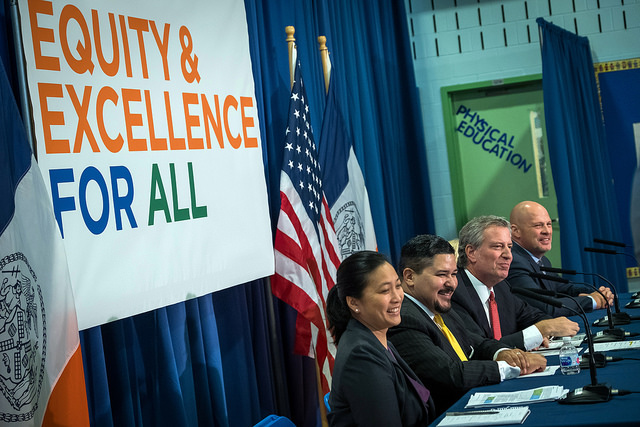
(photo: Ed Reed/Mayoral Photography Office)
For decades, school and district leaders across the country have struggled to answer a fundamental question: how to turn the tide for our nation’s lowest-achieving schools. Some have resorted to school closures, choosing to start anew and relocate those students to better-performing options. Others have tried to “turn around” underperforming schools, in the hopes that an influx of resources, a greater emphasis on data, and strong leadership could spur improvements in student achievement.
Mayor Bill de Blasio’s Renewal program, in particular, highlighted the promise of that alternative to school districts across the country. Rather than shutter 94 poorly performing schools across New York City, he provided a slew of targeted supports that included additional teacher training, new curricula, extra mental health counseling, and resources from community-based organizations. These additional services came with the conditions that schools set clear goals and remain accountable for sustained improvement.
Over the course of four years, Renewal reflected a clear commitment to supports over school closures and a systems-wide approach; important ingredients of a successful turnaround effort. However, the initiative failed to incorporate input from practitioners and community members, creating a disconnect between policies and ideals—and the actual work of teaching and learning within their classrooms.
Earlier this month, Mayor de Blasio had no choice but to end his $773 million school turnaround experiment, facing scrutiny over not only a lack of local engagement, but the nearly 75 percent of Renewal schools that failed to exhibit significant improvement over four years.
In the wake of this latest setback, district leaders and policymakers across the country are still searching for the answer to this fundamental question. Atlanta Public Schools has shifted to a broader, system-wide effort to elevate all 89 schools in the district. Rhode Island continues to grapple with the ongoing struggles of its turnaround schools, even amid promising practices like common planning time for teachers, culturally responsive curricula, and concerted family engagement efforts. And Tennessee is experimenting with approaches that range from state-run school districts to innovation zones that offer extra resources and charter-like autonomy.
School turnaround remains one of the greatest challenges in education today. Yet, in response to this challenge, we are not using tools and strategies that have actually proven to increase student achievement. Research that my colleague and I conducted last fall shows that only 11 percent of service providers supporting the work of school turnaround have demonstrated evidence of impact.
While some providers may not have been evaluated yet, and others offer consultations or services that are more difficult to measure, the key take-away here is that states and districts are prioritizing partnerships with providers that have never demonstrated evidence their turnaround tools work.
For an issue as intractable as school turnaround, shouldn’t we put our best strategies forward?
First and foremost, we need to recognize that school turnaround begs a system-wide approach, a tenet that Renewal did take to heart. New York City Department of Education officials strove to leverage an ecosystem of partners to support students’ academic, psychological, social-emotional, and basic needs. Renewal’s successor, the Comprehensive School Support initiative, will offer a similar, system-wide approach, leveraging a data-driven system to surface the resources and supports that all students need.
What is still missing from this picture is deep engagement of stakeholders across the school building and broader community. In a system-wide approach, district officials must work side-by-side with principals, educators, school support staff, health providers, out-of-school time providers, and community leaders to establish an overarching change vision for each school.
They must investigate the traditional causes of decline and failure, ranging from significant teacher and leader turnover to chronic budget cuts and a lack of community engagement. And they must take on the role of offering the evidence-based, capacity-building tools and resources that this ecosystem of partners needs to successfully off-set those root causes.
Most importantly, they must accept that effective school turnaround is a long-term effort, not to be achieved in just three years.
Over time, we have worked with Gallup-McKinley County Schools in New Mexico, one of the largest and poorest districts in the state, which has recorded substantial, enduring increases in student proficiency. And in Ohio, a network of 20 turnaround schools demonstrated significant gains in student achievement.
Undoubtedly, school turnaround will remain one of education’s most difficult challenges. However, we now know it can be done with an attention to system-wide stakeholder engagement, evidence-based tools, and the right supports from our school districts.
Mayor de Blasio and Chancellor Carranza should take note as they make their next attempt at turning around New York City’s struggling schools.
***
Coby Meyers is associate professor at the University of Virginia School of Education and Human Development and Chief of Research for the UVA Darden/Curry Partnership for Leaders in Education, an initiative that has supported effective school turnaround efforts in New Mexico, Ohio, and districts across the country.
***
Have an op-ed idea or submission for Gotham Gazette? Email This email address is being protected from spambots. You need JavaScript enabled to view it.




